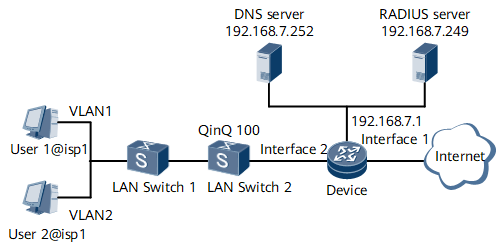Example for Configuring IPoEoQ Access
This section provides an example for configuring IPoEoQ access.
Networking Requirements
On the network shown in Figure 1, the networking requirements are as follows:
A user accesses the network through GE 0/1/2.2 on the device in IPoEoQ mode. LAN switch 1 tags user packets with VLAN 1 and VLAN 2. LAN switch 2 tags user packets with QinQ 100 (outer VLAN 100).
The user belongs to the domain isp1 and adopts binding authentication and RADIUS accounting.
The IP address of the RADIUS server is 192.168.7.249. The authentication port number is 1812, and the accounting port number is 1813. The standard RADIUS protocol is adopted. The shared key is it-is-my-secret1.
The IP address of the DNS server is 192.168.7.252.
Configuration Roadmap
The configuration roadmap is as follows:
Configure authentication and accounting schemes.
Configure a RADIUS server group.
Configure an address pool.
Configure an authentication domain.
Configure a BAS interface and an upstream interface.
Data Preparation
To complete the configuration, you need the following data:
Authentication template name and authentication mode
Accounting template name and accounting mode
RADIUS server group name, and IP addresses and port numbers of the RADIUS authentication server and accounting server
IP address pool name, gateway address, and DNS server address
Domain name
BAS interface parameters
Procedure
- Configure AAA schemes.
# Configure an authentication scheme.
<HUAWEI> system-view [~HUAWEI] aaa [~HUAWEI-aaa] authentication-scheme auth1 [*HUAWEI-aaa-authen-auth1] authentication-mode radius [*HUAWEI-aaa-authen-auth1] commit [~HUAWEI-aaa-authen-auth1] quit
# Configure an accounting scheme.
[~HUAWEI-aaa] accounting-scheme acct1 [*HUAWEI-aaa-accounting-acct1] accounting-mode radius [*HUAWEI-aaa-accounting-acct1] commit [~HUAWEI-aaa-accounting-acct1] quit [~HUAWEI-aaa] quit
- Configure a RADIUS server group.
[~HUAWEI] radius-server group rd1 [*HUAWEI-radius-rd1] radius-server authentication 192.168.7.249 1812 [*HUAWEI-radius-rd1] radius-server accounting 192.168.7.249 1813 [*HUAWEI-radius-rd1] radius-server shared-key-cipher it-is-my-secret1 [*HUAWEI-radius-rd1] commit [~HUAWEI-radius-rd1] quit
- Configure an address pool.
[~HUAWEI] ip pool pool1 bas local [*HUAWEI-ip-pool-pool1] gateway 10.82.0.1 255.255.255.0 [*HUAWEI-ip-pool-pool1] commit [~HUAWEI-ip-pool-pool1] section 0 10.82.0.2 10.82.0.200 [~HUAWEI-ip-pool-pool1] dns-server 192.168.7.252 [*HUAWEI-ip-pool-pool1] commit [~HUAWEI-ip-pool-pool1] quit
- Configure an authentication domain.
[~HUAWEI] aaa [~HUAWEI-aaa] domain isp1 [*HUAWEI-aaa-domain-isp1] authentication-scheme auth1 [*HUAWEI-aaa-domain-isp1] accounting-scheme acct1 [*HUAWEI-aaa-domain-isp1] radius-server group rd1 [*HUAWEI-aaa-domain-isp1] commit [~HUAWEI-aaa-domain-isp1] ip-pool pool1 [~HUAWEI-aaa-domain-isp1] quit [~HUAWEI-aaa] quit
- Configure Ethernet interfaces.
# Configure user—side VLANs.
[~HUAWEI] interface GigabitEthernet 0/1/2.2 [*HUAWEI-GigabitEthernet0/1/2.2] user-vlan 1 2 qinq 100 [*HUAWEI-GigabitEthernet0/1/2.2-vlan-1-2-QinQ-100-100] commit [~HUAWEI-GigabitEthernet0/1/2.2-vlan-1-2-QinQ-100-100] quit
# Configure a BAS interface.
[~HUAWEI-GigabitEthernet0/1/2.2] bas [~HUAWEI-GigabitEthernet0/1/2.2-bas] access-type layer2-subscriber [*HUAWEI-GigabitEthernet0/1/2.2-bas] default-domain authentication isp1 [*HUAWEI-GigabitEthernet0/1/2.2-bas] authentication-method bind [*HUAWEI-GigabitEthernet0/1/2.2-bas] commit [~HUAWEI-GigabitEthernet0/1/2.2-bas] quit [~HUAWEI-GigabitEthernet0/1/2.2] quit
# Configure an upstream interface.
[~HUAWEI] interface GigabitEthernet 0/1/1 [*HUAWEI-GigabitEthernet0/1/1] ip address 10.10.7.1 255.255.255.0 [*HUAWEI-GigabitEthernet0/1/1] commit [~HUAWEI-GigabitEthernet0/1/1] quit [~HUAWEI] quit
- Verify the configuration.
After the configuration is complete, you can run the display access-user domain command to view information about online users in the domain.
<HUAWEI> display access-user domain isp1 ------------------------------------------------------------------------------ UserID Username Interface IP address MAC IPv6 address ------------------------------------------------------------------------------ 20 user1@isp1 GE0/1/2.2 10.82.0.5 00e0-fc12-3456 - 21 user2@isp1 GE0/1/2.2 10.82.0.6 00e0-fc12-3457 - ------------------------------------------------------------------------------ Total users : 2
Configuration Files
# sysname HUAWEI # radius-server group rd1 radius-server shared-key-cipher %^%#clY:%[]x='-RMNJus[s/VJ:3YBq3<..|.{'xgbp+%^%# radius-server authentication 192.168.7.249 1812 weight 0 radius-server accounting 192.168.7.249 1813 weight 0 # ip pool pool1 bas local gateway 10.82.0.1 255.255.255.0 section 0 10.82.0.2 10.82.0.200 dns-server 192.168.7.252 # aaa # authentication-scheme auth1 # accounting-scheme acct1 # domain default0 # domain default1 # domain default_admin domain isp1 authentication-scheme auth1 accounting-scheme acct1 radius-server group rd1 ip-pool pool1 # interface GigabitEthernet0/1/1 ip address 10.10.7.1 255.255.255.0 # interface GigabitEthernet0/1/2.2 user-vlan 1 2 qinq 100 bas # access-type layer2-subscriber default-domain authentication isp1 authentication-method bind # return

